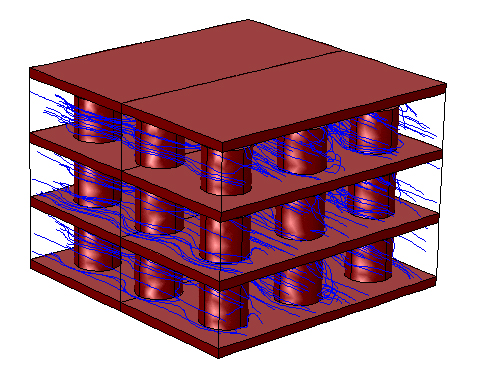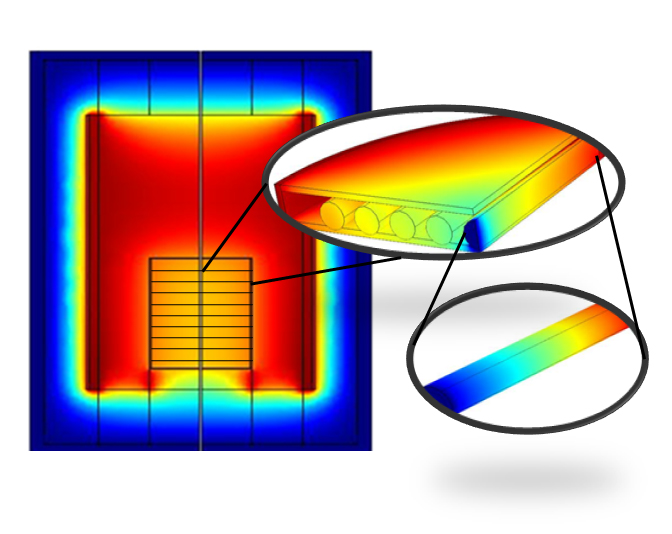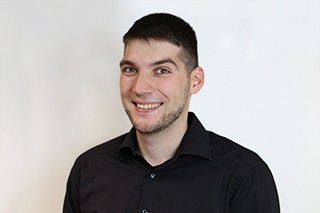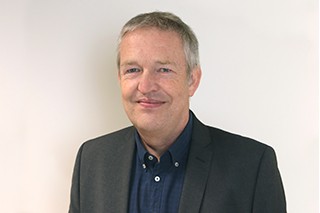In industrial heat treatment processes, large-volume furnaces are generally used to maximize the throughput of the material. The transfer of the heat from the heaters to the medium takes place by means of convection and heat radiation in the furnace atmosphere as well as by heat conduction in the combustion aids used and in the material itself. In rarer cases, volumetric or radiation heat processing is used, which transmits the heat directly to the material with electromagnetic radiation (microwaves, induction, infrared light). During cooling, the heat flow reverses. In any case, the heat distribution in the useful volume plays an important role for the quality of the heat treatment. The cost-efficiency of the heat processes and frequently also requirements of the material require the shortest possible temperature cycles, meaning steep heating and cooling ramps. This results in undesirable temperature gradients and thermal stresses in the useful volume. In this target conflict, careful thermal management is required.
Heat management in industrial furnaces is carried out at the Fraunhofer-Center HTL using finite element (FE) methods. The FE methods are applicable to all types of furnaces, e.g., hearth furnaces, roller ovens, hood ovens. They are based on a simplified illustration of the complex furnace geometry in FE models. Frequently, multiscale models are used to reduce computing costs. In this case, parts of the usable volume, e.g., individual combustion capsules with the material contained therein, are simulated. Their thermal properties are homogenized and used in models on the next larger scale. Through the use of the FE methods, all relevant heat transport processes (heat radiation, heat conduction and convection) can be simulated at the HTL.
The quality of the FE simulation depends on the accuracy of the input data. The available material data for many relevant materials - especially in the high-temperature range - are not sufficient. The material data required for the FE simulation are therefore determined at the HTL center using specially developed ThermoOptical measurement methods (TOM) for temperatures of up to 2000 °C and higher. For example, the temperature conductivity and emissivity of refractory materials can be measured by means of special LaserFlash and IR methods. The mobile measuring stand for industrial furnaces developed at the HTL can also be used to generate input data for the FE simulation. For example, gas flows and temperature distributions in the industrial furnace can be measured directly on site. The measurements with the mobile measuring stand can also be used to validate the simulation calculations.
The calculation of the temperature distribution in the heating material is used at the HTL to calculate the result of the heat treatment. For this, robust formal-kinetic models are used. The formal-kinetic models use in-situ measurement data, which are measured directly during heating in the heat treatment. For this purpose, the industrial heat treatment process is simulated in TOM plants at the HTL with the relevant furnace atmospheres. The parameterized measurement data are used in special FE models to couple reaction kinetics, temperature calculation and mechanical effects. For example, the process parameters for debinding and sintering of materials produced via the powder route can be optimized in this way.
Another important field of application for heat management in industrial furnaces is the mechanical stresses which occur as a result of temperature gradients or rapid temperature changes in the furnace components, combustion aids or the components to be treated. For example, the thermal shock occurring during rapid cooling can drastically reduce the service life of combustion aids, or the temperature differences present in the furnace insulation can lead to cracks and heat leaks. At the HTL center, the mechanical stresses occurring in the industrial furnace are calculated in coupled thermal-mechanical FE models. For the evaluation of the FE results, measurements can be performed in the TOM plants with which high temperature gradients or rapid temperature changes up to high temperatures are generated. If required, the FE simulations can be combined with analyzes on the lifetime of refractory materials.
With the help of the heat management, it is possible to optimize the set-up structures with regard to low temperature gradients and long service life of the combustion aids. A targeted selection of suitable refractory materials is also possible due to the heat management in industrial furnaces. The heat capacity of the combustion aids can be minimized in the sense of an increase in the energy efficiency of the heat treatment. In addition, process parameters, such as the temperature cycle or the gas flow, can be adapted so that the target conflict between an economic operation of the furnace installation and the best possible quality of the product is solved in terms of the specific customer requirement.
An advantage of the heat management methods used at the HTL is the high degree of abstraction of the geometric FE models coupled with the very precise experimental data. In most cases, FE models for industrial furnaces require a very high computational effort. Therefore, robust models with comparatively short computing times were developed at the HTL. The precise input data of the FE simulation ensure the high accuracy required for process optimization. With the help of heat management, it is also possible to process specific questions within a furnace without having to simulate the entire furnace, which allows a focus on particularly critical problem areas.
 Fraunhofer ISC, Center for High Temperature Materials and Design HTL, Bayreuth
Fraunhofer ISC, Center for High Temperature Materials and Design HTL, Bayreuth


